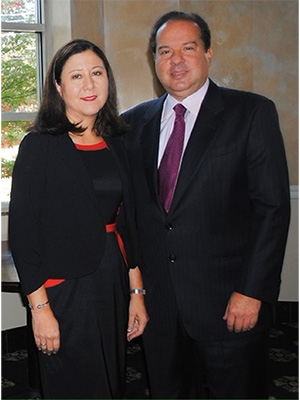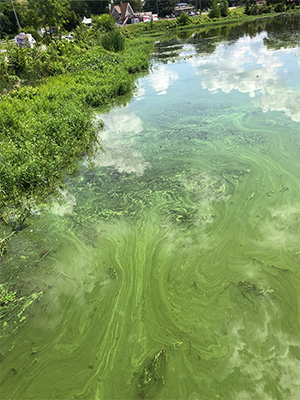Generations of Care, Years of Discovery: Skaneateles Lake As a Living Lab
Summer 2025 Issue
 Generations of Care, Years of Discovery: Skaneateles Lake As a Living Lab
Generations of Care, Years of Discovery: Skaneateles Lake As a Living Lab
- Claire B. Dunn
A $2 million gift from philanthropists Sam and Carol Nappi, will support expanded research into the cause of harmful algal blooms (HABs) that threaten human health, with an ESF research team using Skaneateles Lake and its watershed as a living laboratory.
Led by Dr. Stephen Shaw, chair of the ESF Department of Environmental Resources Engineering, a team of researchers from across several academic disciplines will spend two years building an extensive data set that can be refined into hypotheses about the nutrient sources in the lake and their connections to HABs. Then, during the next two years, the researchers hope to start testing possible solutions while continuing to do baseline monitoring.
“ESF is uniquely positioned to make a difference. Given the recent cuts in federal research funding, Carol and I encourage others to give at a time its needed most."
Sam Nappi
“This gift will allow us to fill in gaps in research that’s been done over the years, and then propose and test some possible solutions,” Shaw said. “The idea is not to study the system indefinitely but to find some solutions. We are looking at phosphorus as a possible contributor to the problem. If, for example, we discover that certain tributaries or features of the landscape tend to have higher phosphorus loads, then we will try to implement some management measures to reduce those loads.”
The funding will support the work of students, including undergraduate and graduate students, and a post-doctoral research assistant in the project. Shaw envisions the development of a new water management course and field experience for ESF students, who would help collect data, evaluate hypotheses and test solutions. Upon graduation, the new alumni would be equipped to take their knowledge to other lakes and help address challenges there.
“This stable source of funding is vital to support the work of students who can do the science to help answer questions and provide solutions to these complex problems,” Shaw said.
Sam and Carol Nappi, formerly of Jamesville, NY, are committed to environmental sustainability and community well-being. Skaneateles Lake and the Finger Lakes region hold deep personal significance to the Nappis, who have long been involved in efforts to maintain quality drinking water from the lake.
“Over 100 years ago my grandfather was involved with the installation of the intake pipes, which serve the City of Syracuse and the surrounding communities”, said Sam Nappi.
 Skaneateles Lake and the Finger Lakes region have held deep personal significance
to the Nappi family for four generations. It is this appreciation and protection of
200,000 peoples drinking water, which drives their commitment to seeing what can be
accomplished beyond government to benefit the long-term health of community and lake.
Skaneateles Lake and the Finger Lakes region have held deep personal significance
to the Nappi family for four generations. It is this appreciation and protection of
200,000 peoples drinking water, which drives their commitment to seeing what can be
accomplished beyond government to benefit the long-term health of community and lake.
“We are grateful to everyone involved for their years of collective action to help manage and protect this vital natural resource and look forward to seeing the solutions that come forward from Dr. Shaw’s research. Soon we will announce additional partnerships to expand this work” said Sam and Carol Nappi.
“We have sincere gratitude for this generous contribution,” said ESF President Joanie Mahoney. “Carol and Sam Nappi are making it possible for water research done at ESF to be deployed right here in our Central New York Community for the benefit of everyone.”
“ESF is uniquely positioned to make a difference. Given the recent cuts in federal research funding, Carol and I encourage others to give at a time its needed most” said Nappi.
HABs have been a subject of research at ESF and beyond for decades. They occur when colonies of algae (simple water-dwelling plants) grow out of control and produce toxic or harmful effects on people, domestic animals and wildlife.
Skaneateles is the drinking water source for the city of Syracuse, which is about 20 miles northeast of the lake. Its pristine water and picturesque village attract tourists year-round. Shaw said that while the lake is the initial focus of research, the findings could likely be applied to other lakes that are troubled by HABs.
“I firmly believe that water is New York State's most valuable resource, if we're going to protect our water, we need to actually understand the why and the who and the how of the things that are threatening that water” said Greg Boyer, ESF emeritus professor of biochemistry and director of the Great Lakes Research Consortium at SUNY ESF.
Skaneateles enjoyed many years with no reports of HABs, but Shaw said they started to surface in the last several years. The research team plans to install a series of shallow wells to monitor nutrient export from septic systems, develop a fluorescence sensor for rapid phosphorus quantification and compare various types of remote sensing in monitoring lake algal blooms. The plan also calls for a collaboration phase consisting of a series of meetings and workshops with stakeholders to help shape solutions that will then be tested.
ESF faculty participating in the research with Shaw, a hydrologist, are Dr. Christine Georgakakos, a specialist in water quality with a focus on agricultural systems; and Dr. Bahram Salehi, who specializes in remote sensing with a focus on fusing data from unmanned aerial vehicles with data from satellites. Joining the team is Dr. Silvana Andreescue of Florida International and Clarkson Universities, an expert in developing novel chemical sensors. A panel of experts, including Boyer, a longtime ESF HABs researcher, will convene semi-annually to review new data and continually refine the research to help find effective solutions.
